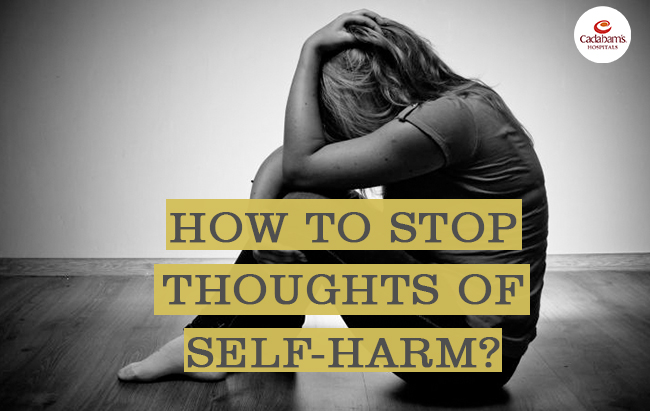Table of Content
Most people, if not a lot of people have a lot of thoughts relating to rage and destruction. Some people tend to inflict harm on others, and some do it to themselves, in the form of self-harm. This is usually in a sense of letting go, but it is very, very harmful for the individual, both mentally and physically.
There is already a very present stigma against mental health in general, and while there are cases of self-harm seen as attention-seeking behavior, this is a very dangerous way to see this. While it can be the case for some, this is definitely not the case for everyone else. There can be a suicidal thought element, as well as a non-suicidal one, and the latter has increasingly become a popular way of coping. Read more to understand how to avoid suicidal thoughts.
What is Self-Harm and Why Do People Self-Harm?
Self-harm is essentially a way in which one hurts oneself, physically usually deliberately. In most cases, this is to cope with overwhelming situations in life or to gain a sense of control when things are falling apart. It is non-suicidal in nature in most cases. Forms such as head-banging, punching, hitting, carving, burning, cutting, and scratching are common.
These are usually maladaptive coping mechanisms. It is naturally different for each person and their circumstances. For some people, it can be something that they do to deal with events of their past, or for things occurring presently. This can be because of stressful events, and in some cases, people don’t know what is causing this. Self-harm is also seen as a method of showing unaccepted feelings.
Certain things that can be a cause of self-harm are as follows- increase stress and pressure at the workplace, death of a loved one, low self-esteem, health and other mental health relating problems, or physical and online bullying/harassment.
What is the Prevalence of Self-Harm?
It is definitely a growing area, as well as a growing area of study. In US adults it is seen that 5.9% of adults engage in self-harm. It is seen that a younger demographic is more likely to self-harm, and about 17% of adolescents have engaged with it at least once. It is more prevalent in young girls than it is in young boys, with 23.8% and 11.3% respectively.
How can you help if you see someone engaging in self-harm?
There are usually some telltale signs that someone is self-harming. If they have cuts, gashes, bruises, and such on their arms, hands, stomachs, they could be self-harming (especially if this is seen to persist over a period of time and isn’t a one-time thing. If they engage in weird behavior such as hair pulling, self-damaging itching and picking, etc then perhaps they are unconsciously engaging in self-harm without even fully knowing about it. Understanding these signs is important to answer the question, How to stop suicidal thoughts?
If they are seen wearing clothes that are covering up their body, especially noticeable in warm weather, it could be a sign they are covering up the scars or cuts. It can also be seen if they are following self-harm accounts on social media.
Depending on the intensity and circumstance, you should talk to them about it. If the self-harm persists over a long period of time, then you should ask them to see a professional, especially if it is literally affecting them on a day-to-day basis.
How can I stop self-harming?
There are things you can do to control the self-harm thoughts, and you can learn healthier coping mechanisms for issues and overwhelming situations in life. This is usually achieved when the vicious cycle is broken.
How to overcome suicidal thoughts?
One can start by identifying what it is that triggers them. This can give signs before the crisis situation arrives itself. If you are aware of what is causing you to get triggered, then you can prepare for these scenarios going forward.
Keeping track of the patterns of self-harm is also essential, which can keep you aware of what you do and how you deal with a stressful situation. Identifying the situation, feelings, people, places that are associated can be the first sign to prevent self-harm.
Eventually, it is also very essential that you find healthier coping techniques. Methods such as journaling, writing, painting, drawing, listening to music, and other such releases can help release the pain we are feeling, and express them in a good way.
If you are attuned to art, then perhaps art therapy might be for you.
Looking after yourself, and self-care is also something that you need to learn to practice as part of how to deal with suicidal thoughts. Some common methods of self-care include hot baths/showers, aromatherapy, listening to calming music, wrapping oneself in a blanket, or getting a massage. If you happen to have a pet, then spending some time with them can make you feel good.
Distracting oneself is also sometimes helpful- watch that movie that you’ve been wanting to watch. Clean your closet that you’ve been putting off for a week. Doing mundane chores sometimes can really help channel your mood in an effective way.
Releasing tension through exercise is also a helpful method- the presence of endorphins is good for the body as well. Not isolating is often a good idea, and this could be a time to vent to someone you can trust, or catch up with a friend. Communicate your needs clearly with these people, and make sure you do what is necessary for you to cope.
Either way, there are simple and doable ways to cope with self-harm. If things seem to be going south, you should definitely reach out to a licensed professional for suicidal thoughts help.
How Cadabam's Help you for Addiction?
- 410+ Professional Consultants
- 1,00,00+ Happy Faces
- 120+ Currently Seeking Treatments










